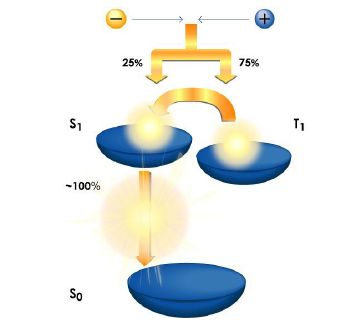Dec
31
Super Efficiency For Organic Light Emitting Diodes
December 31, 2012 | 3 Comments
Great advances have been made in the development of materials for organic light-emitting diodes (OLED) in recent years. The Center for Organic Photonics and Electronics Research (OPERA) of Kyushu University announced that it has developed a new OLED light-emitting material that is a fluorescent material and has an internal quantum efficiency of better than 90%.
So far only phosphorescent materials using expensive rare metals have had high internal quantum efficiencies. But OPERA’s new material does not use a rare metal.
OLEDs are classified into two groups. There are fluorescent and phosphorescent materials that are distinguished by the difference of light emission principle. Fluorescent materials are recombined (emit light) only when excitors go through a spin state called “singlet state”. The other type, phosphorescent materials, emit light not only when they are in the singlet state but also when they are in a spin state called “triplet state.”
Now because the ratio of the occurrences of the singlet and triplet states is 1:3, it has been considered that the maximum internal quantum efficiency of fluorescent materials would be 25% and internal quantum efficiency of phosphorescent materials could 100%. The problem is the energy of fluorescent material’s excitors in the triplet state is not used for light emission because most of it is lost as heat.
This situation leads to the difference in the luminous efficiency of an OLED device. Therefore more phosphorescent materials are being employed in the development of OLED displays and OLED lighting apparatuses. OLED devices whose luminous efficiencies are higher than 50lm/W are made with phosphorescent materials except for the blue light-emitting materials. With the rare metals used that means very high prices.
There are problems with phosphorescent materials. First is they are expensive because they contain rare metals. Second, Universal Display Corp (UDC) owns the basic patents related to phosphorescent materials, and it is necessary to negotiate with UDC before using them. Third, the life of blue light-emitting phosphorescent materials is so short that most of them cannot be used for practical purposes.
Progress has some fluorescent materials having internal quantum efficiency higher than the aforethought 25% maximum.
Adachi’s lab at OPERA took notice of this trend and called one of their light emission principles “thermally activated delayed fluorescence (TADF)”. With that idea in hand Adachi started research on the design of a material that increases the luminous efficiency of TADF.

TADF Principle in Action Diagram. Excitors in the triplet state (T1) are “promoted” to the singlet state by heat energy. Click image for the largest view.
The newest TADF emits light only when excitors go through the singlet state. In that sense, it is a fluorescent material. But the excitors in the triplet state are “excited” to the singlet state by heat. Therefore, every excitor has a possibility of contributing to light emission.
At the time the paper was submitted to Nature the research Adachi’s lab had developed materials whose internal quantum efficiencies are 90% or higher by using the TADF principle. They use low-molecular materials consisting of five to nine benzene rings and do not require any rare metal or rare earth material.
Adachi’s lab has build prototypes of the OLED device and displays by using the new molecular materials.
For users the effect is getting better. The power consumption is going down, most impressively on the internal scale measurements. To the eye, the external quantum efficiency of the TADF device is 19% or higher, which is equivalent to the external quantum efficiency of a device using a rare element based phosphorescent material. Call that a success.
At this point, a green light-emitting material has the highest efficiency, but Adachi said, “We will be able to emit lights of most colors including deep blue.”
OLEDs have been expected for a few years now and have turned up in some high-end small displays. The rare earth metal matter has kept OLEDs out of the mass market. While the development to the millions of displayed colors level hasn’t been worked out yet for production, it looks like that will be coming fairly soon.
The news is encouraging; another price drop and efficiency gain would be worthwhile. The only problem is the OLED is the current leading unrealized technology and if it’s manufacturing and economic conditions are solved for the mass market – what would come next?
Comments
3 Comments so far



Please, change excitoRs for excitoNs in the text. It is not necessary to publish this comment. Cheers!
Brian,
Thanks for the 5 posts a week during 2012.
Happy New Year,
Jim
Yes Brian,
Your work here is much appreciated. Have a happy New year!